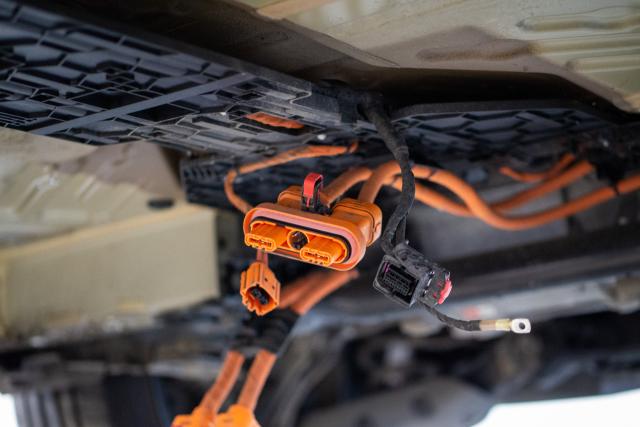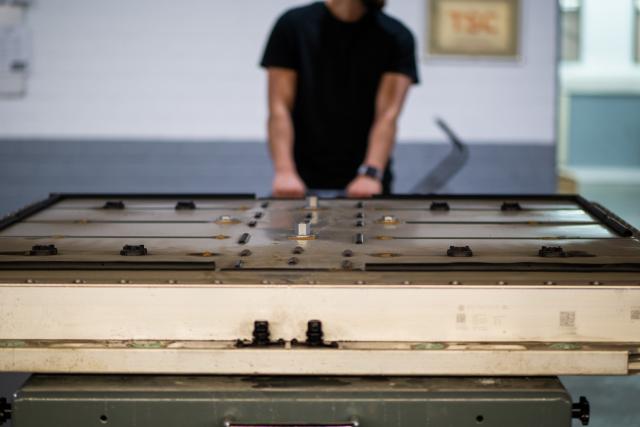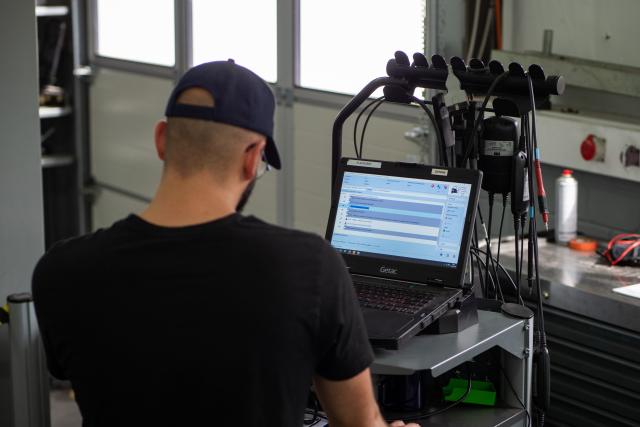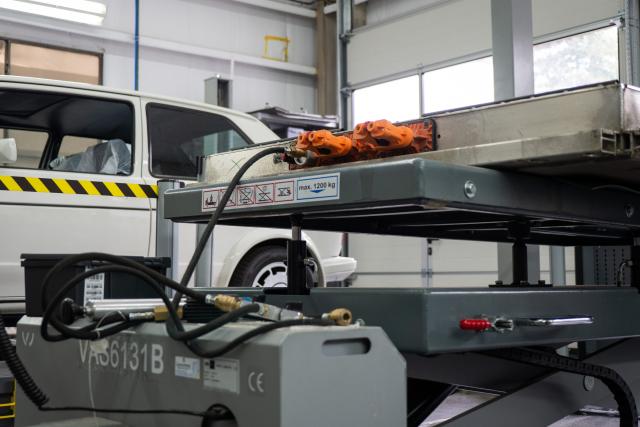E-volution - The Life of a Battery
Sponsored content Switch to German for original article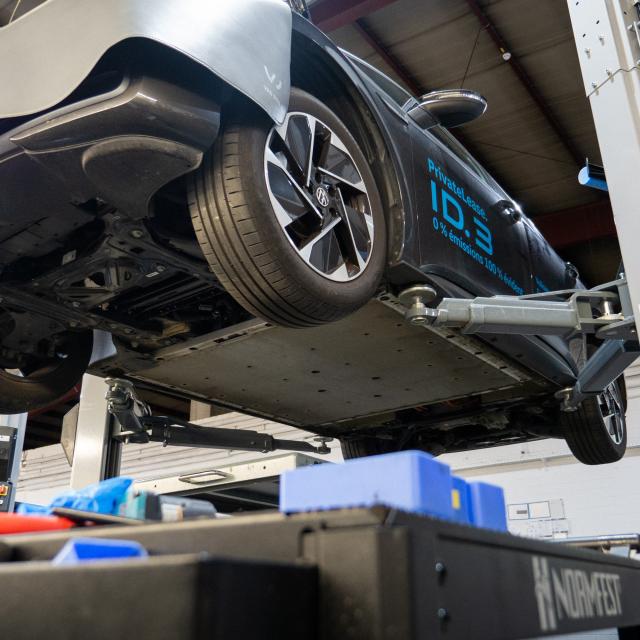
Listen to this article
We dive into the world of electromobility in this series with SWIO and show the way people, whether convinced users or pioneers, think. We also explain the exciting developments in this field and show how visions of the future are gradually becoming reality.
An electric motor is the drive type that has the highest efficiency. This is the conclusion of the Berlin-based think tank "Agora Verkehrswende für klimaneutrale Mobilität". With a common petrol engine, 80% of the energy supplied is lost by the time it reaches the vehicle wheel, whereas the loss with an electric car is only 31%, according to the result of their analysis. And the energy source that powers the electric motor is also developing rapidly. "You have to stay on the ball. Continuing education is part of the daily job. You have to enjoy it and it has to suit you, " says Sven Krump, who specialises in battery repair for VW Group vehicles at Losch Import.
When you visit his workplace, you initially have the impression that you're in a random car repair shop. Until one of the employees rolls up with a scissor lift. "We have found a new task for this one, " Sven Krump emphasises with a smile on his face. Actually, such lift tables are used to remove engines from conventional cars. But they are also ideal for transporting the heavy batteries of electric cars, which can weigh up to 750 kg. Today, the battery of an ID.3 is being removed because one of the battery cells needs to be replaced. "The removal is relatively easy to master. The first batteries were still complicated in terms of their structure, as in the e-Golf, for example. But that has changed. The battery of the ID.3 looks like a bar of chocolate from the inside. In terms of wrenching skills, it's manageable, " says Krump. The actual effort, he says, has partly to do with the acquisition of special tools. "The equipment you need is enormous. The tools we have purchased for battery repair alone amount to six figures."

Sven Krump


And you have to be able and allowed to operate these tools. Sven Krump trained as an automotive mechatronics technician. In 2005 he became a service technician at VW, followed by a master craftsman's certificate, and 10 years later he won the RQWC (Retail Qualification World Championship) in this capacity. This professional championship is about theoretical and practical knowledge and skills. In 2015, he landed at Losch as a product supervisor and has been head of the customer service workshop since 2020.
"As far as electrical hazards are concerned, high-voltage technology naturally has a risk potential, " Sven Krump points out. "You have to pay attention to safety. When you work on the electrical system of a high-voltage vehicle, you must first disconnect the high-voltage system from the power supply. The maintenance plug is disconnected and sealed with a lock. The employees who do this have undergone special training. They are high-voltage technicians. Then there is an additional level. Only the so-called high-voltage experts are allowed to work on the inside of the actual battery, because the battery is always live. You have to be careful what you do." That's why two people always work on a battery at the same time and also wear special protective clothing.
"The tools we have purchased for battery repair alone amount to six figures."
Sven Krump
At the moment, this one workshop is enough to cover Losch's needs. There are only 2–3 battery repairs a month. In most cases, the sheet metal of the battery housing has been damaged and the cover has to be replaced. The on-board computer of the electric car monitors the battery and problems are immediately shown to the driver in the display. "If the status warning is displayed, it is an electrical fault, for example if the computer can no longer connect to the battery. The status danger indicates that the battery is reacting thermally or has developed smoke. We haven't had such a case yet, " says Krump. For safety reasons, after an accident or if the battery status is unknown, the electric car is taken to a quarantine area where it stands alone and nothing flammable is around. This is because the fire brigade should have direct access in the event of a thermal reaction. If there is no reaction after two days, it can be worked on.


A battery has several lives. Once it has served its purpose in a Losch electric car, it is sent to SNAM in France. The company, based in Viviez in the department of Aveyron, has specialised in recycling since it was founded in 1977. While it used to be more involved in metal refining, today it mainly recycles batteries and produces secondary raw materials. Between 2010 and 2021 alone, 17.7 million vehicles with lithium-ion batteries were put on the market worldwide, 5.7 million of them in Europe. This equates to 2 million tonnes of batteries that will need to be recycled. Frédéric Salin, Director of Sales and Marketing at SNAM, explains: "75% of the batteries we recycle come from our logistics partners in Europe. We also have partnerships with collection networks that are authorised to transport hazardous waste. The aim is to return raw materials to the production cycle of steelworks, foundries or even battery manufacturers. This is called a closed loop, which we can keep very small from battery to battery in the case of cadmium, for example."
Every manufacturer – also called an OEM (original equipment manufacturer) – has a regulatory obligation to ensure that its batteries are recycled. But Frédéric Salin explains that it is currently not possible to fully recycle the quantities of batteries put on the market in Europe. There are very few players in this field on the continent. That is why they are resorting to an interim solution. "Batteries from electric cars, when they are recycled, no longer have enough capacity to power an electric car, but still have sufficient electrical density for other tasks. This is where the second life cycle begins, " says Frédéric Salin. The battery is first diagnosed. Then it is opened, dismantled down to the smallest removable component and each element is diagnosed again individually. The cells that are still usable are recombined at Phenix Batteries, which belongs to the SNAM group of companies, fitted with a new battery management system and brought to market as a new battery. "End of life is not prevented, but time is gained in that these battery cells will have a lifespan of 20–25 instead of 10–15 years."
There is strong competition between car manufacturers to offer the best battery to customers. Which in turn makes recycling more difficult for SNAM. After all, ideally this process should be simple and quick. "A battery can never be 100% recycled for technical and economic reasons. The world is a place of compromise, " admits Frédéric Salin. "But we want it to be easy to dismantle and we don't want to use complex materials. For example, certain easily recyclable plastics are used in batteries, such as polypropylene. But for safety reasons, additives are mixed in, including fire retardants, to avoid thermal overload. Those elements are very problematic and no longer allow for the recovery of these materials. In terms of recycling and the circular economy, this is not optimal." By the way, a European regulation is supposed to make the reuse of recycled raw materials mandatory in the production of new batteries from 2030.



The Luxembourg materials scientist Dr Félix Urbain follows developments in this field with interest and praises the conservation of resources in the industrial recycling of batteries, which also produces fewer pollutants. Due to his profession, he has always looked far ahead. He sees electromobility as a necessary cornerstone for a climate-neutral society. "On average, you already have a positive climate balance with an electric car after 60,000 kilometres, " Urbain calculates. "Even the somewhat higher initial investment is quickly offset by the much lower maintenance costs. And with an electric car you are always sure to be at the cutting edge of technology." Many developments are not entirely transparent because the various manufacturers don't want to show their cards. For Félix Urbain, however, research shows that the optimisation potential of batteries is far from exhausted.
"The road from laboratory to mass production is generally long and there are many hurdles."
Dr Félix Urbain
Since the first commercial use of lithium-ion storage technology over 30 years ago, the energy density in such batteries has quadrupled. Great progress has also been made in recent years in temperature management during charging and discharging and in service life. "The next step is the development of solid-state batteries, in which the electrically charged particles can move much faster than ions in the liquid electrolyte of conventional batteries. Eliminating the liquid electrolyte will make the batteries lighter, safer and less complex, among other things." Dr Urbain sees the most promise in the development of solid-state ceramic batteries. "The problem is that the road from laboratory to mass production is generally long and there are many hurdles. A lab test is no guarantee of a well-functioning final product. A crucial bottleneck, for example, is when components react with each other in the prototype and this could not be predicted on a small scale. Then the work starts all over again."

Dr Félix Urbain
The materials scientist sees a need for constant further development especially with regard to the raw materials currently used. "Lithium is admittedly available in great quantity. 90% of the lithium extracted is not even used for batteries. But raw materials like nickel and cobalt, for example, are becoming rarer and more expensive, as are rare earths." Copper is also needed in ever greater quantities, he says, as it is not only used in batteries, but also in electric motors, solar panels and wind turbines. When Dr Félix Urbain talks about possible alternatives and solutions, one realises that there is one resource that is not limited – namely the ingenuity of man.
On the way to the age of electromobility, the head of Losch's customer service workshop Sven Krump has one more tip. "A high-voltage battery naturally ages, especially if it is constantly charged to 100%. But for daily use, that is not necessary at all. That's why in our cars, in the menu where you can configure the battery charge, the maximum charge level is set to 80% by default." Only when driving a longer distance, such as a holiday trip, is it advisable to set a timer with a charging target of 100% for the exact time of departure. Then the standing time with a fully charged battery is very short.
Why use a wallbox at home?
-
A wall charging station can regulate the flow of electricity, which is gentler on the home's electrical installation. SWIO is a 360° charging management solution for electric and plug-in hybrid vehicles. With its charging capacity of 11 kW, the SWIO wallbox enables charging five times faster than at a household socket and is suitable for all e-vehicles thanks to its universal charging plug. The SWIO app and RFID card guarantee secure access to the wallbox. With the smartphone, the charging processes can be configured and controlled, and even adapted to the energy consumption of the entire house. For more information, visit www.swio.lu.
-
An appointment is made with the SWIO installation partner for a house check. The architectural conditions are checked and the application for the grid operator is filled out and sent in. In Luxembourg, all e-car charging systems with a capacity of more than 7 kW for three-phase connections (4.6 kW for single-phase connections) must be applied for and subsequently approved by the grid operator.
After the application has been approved, the SWIO installation partner arranges a second appointment to install and commission the SWIO wallbox. At a further appointment, the grid operator checks whether the wallbox has been connected in accordance with the applicable technical guidelines.
Each e-car charging system is connected to the SMARTY electricity meter with a control cable. If the grid is overloaded, the grid operator can switch the wallbox to a reduced load shedding mode. This means that the wallbox charges at reduced power for the required time. Afterwards, it automatically returns to normal charging mode, i.e. it charges again at maximum power. With the SWIO wallbox, you can therefore always charge, unlike other charging installations that cannot adjust their charging power.
-
The state subsidises intelligent charging points such as the SWIO wallbox with 50 percent of the acquisition costs (excl. VAT) and up to a maximum amount of 1,200 euros.



